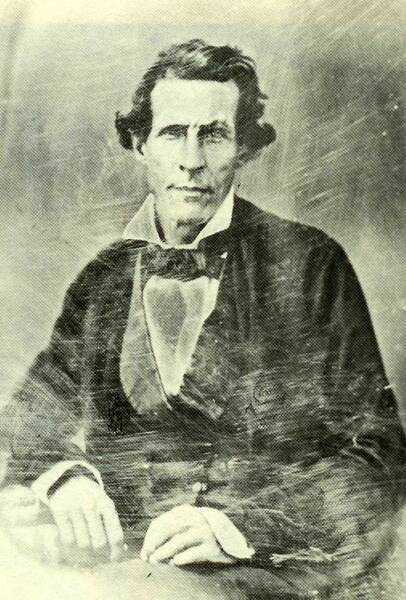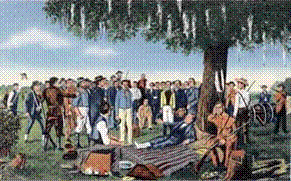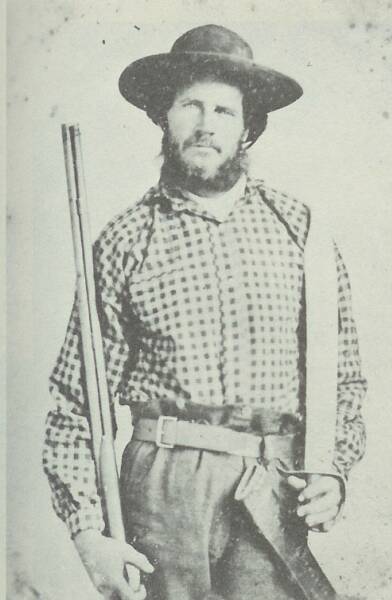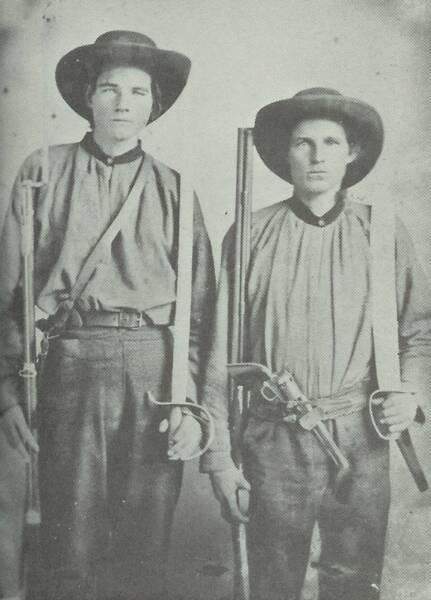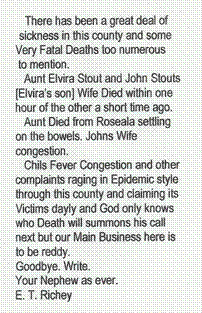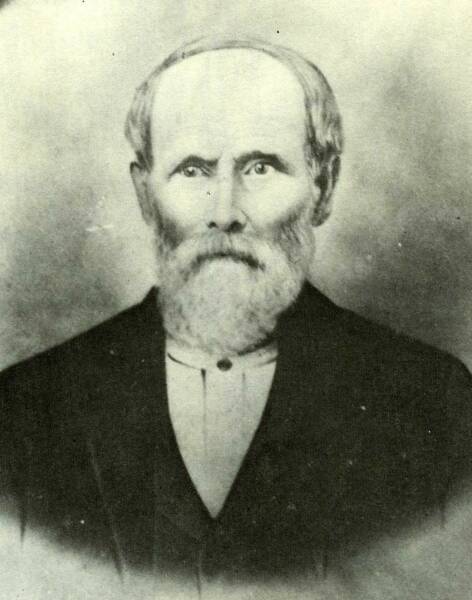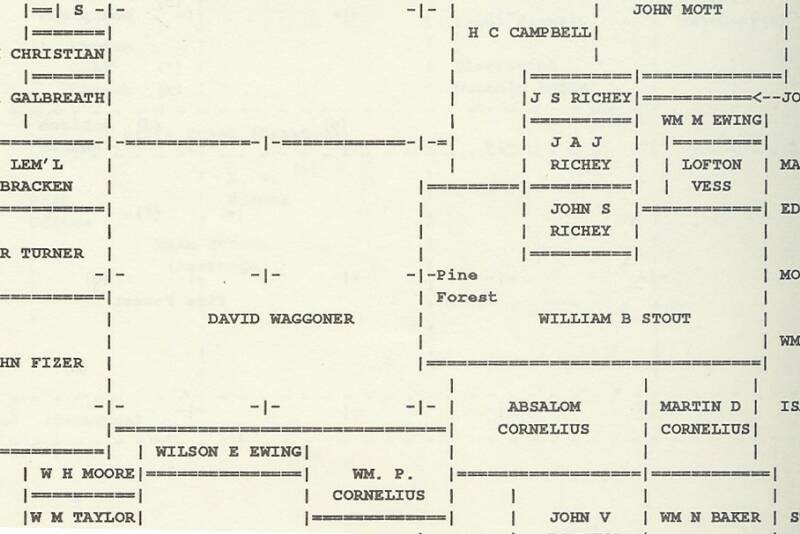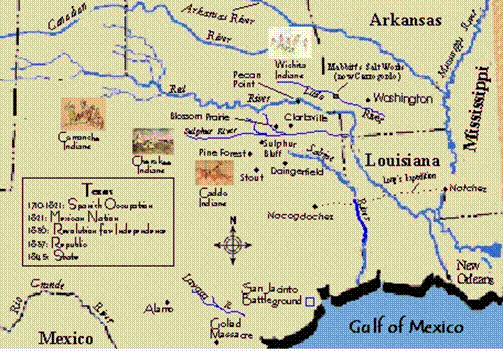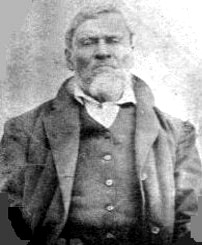Frontiersman James Selen Stout To arrive at a just estimate of a renown man's character
one must judge it by the standards of the time, not ours
--- Mark Twain
It was said that when Selen was hunting and cornered a animal of his search,
that he could invariably determine the position of its body by the movements of the eye. 
 In Hopkins County, Texas, in the late 1850’s Selen, as James Selen Stout was
In Hopkins County, Texas, in the late 1850’s Selen, as James Selen Stout was
called, and his neighbor Bill Hogsett spent many hours fire hunting at night. They would
go into the woods, build a campfire, and sit around it while the dogs went off hunting. By
listening to the nuanced barks and yaps of the dogs, they could tell exactly the progress
of the hunt; whether the trail was cold or hot or whether the quarry had been cornered. Once the dogs had treed the animal of their pursuit, Selen and Bill would then go to them.
These men variously hunted turkey, raccoon, deer, bear, catamount, and wolf. Selen was the champion bear hunter in the area. He used a flint and steel rifle, and was usually successful in securing his game. He kept a trained slow track dog upon which he relied, and it was said that his faithful dog never deceived its master. On one occasion this dog barked all night at a tree in the woods nearby his house. When the tree was visited in the morning by Selen it proved to be a bee tree with a good bit of honey.
 There are those gifted with the aptitude, motivation, and persistence for doing special things. Some write great musical symphonies. Others invent new things. And, there are those who are adept at repairing broken things, including the human body. In a similar fashion, there are those who are adventurous and want to see what is on the other side of the mountain. It is hard for them to get lost, for they seem instinctively to always have their bearings. Be it rain, storm, or bitter cold, they are always adaptive and in tune with their natural surroundings. If necessary, these people can survive by foraging off the land. Selen Stout was one such person.
There are those gifted with the aptitude, motivation, and persistence for doing special things. Some write great musical symphonies. Others invent new things. And, there are those who are adept at repairing broken things, including the human body. In a similar fashion, there are those who are adventurous and want to see what is on the other side of the mountain. It is hard for them to get lost, for they seem instinctively to always have their bearings. Be it rain, storm, or bitter cold, they are always adaptive and in tune with their natural surroundings. If necessary, these people can survive by foraging off the land. Selen Stout was one such person.  In 1817, at the age of 18, Selen’s father, Henry Stout, tired of his own tyrannical father, left Illinois on foot and headed toward Texas. At the frontier settlement of Washington, in Missouri Territory (later Hempstead County, Arkansas), he stopped. It was here that he married 16 year-old Sarah Mary Talbot. On August 30, 1818, a boy was born to Henry and Sarah. They named him James Selen1.
In 1817, at the age of 18, Selen’s father, Henry Stout, tired of his own tyrannical father, left Illinois on foot and headed toward Texas. At the frontier settlement of Washington, in Missouri Territory (later Hempstead County, Arkansas), he stopped. It was here that he married 16 year-old Sarah Mary Talbot. On August 30, 1818, a boy was born to Henry and Sarah. They named him James Selen1.
 At the time, Washington was the extreme out-post of Anglo-American settlement toward the southwest. Missouri Territory got its name from the dividing up of the land in 1812 acquired from the Louisiana Purchase. Missouri Territory would be the upper portion of the Purchase, whereas Orleans Territory would be the southern part. Later these would be the states of Arkansas and Louisiana. As described by writers who traveled through early Washington, its inhabitants had the worst moral character imaginable. Many of them were renegades from justice, who engaged in underground slave trade by selling Mexican and Indian people to the eastern market. They often obtained livelihood by making and selling whiskey and cheating newcomers and Indians by any means possible. Others were outright outlaws, preying on all decent people, and when further flight became necessary, they would pass over into Spanish Territory, which is now Texas.
At the time, Washington was the extreme out-post of Anglo-American settlement toward the southwest. Missouri Territory got its name from the dividing up of the land in 1812 acquired from the Louisiana Purchase. Missouri Territory would be the upper portion of the Purchase, whereas Orleans Territory would be the southern part. Later these would be the states of Arkansas and Louisiana. As described by writers who traveled through early Washington, its inhabitants had the worst moral character imaginable. Many of them were renegades from justice, who engaged in underground slave trade by selling Mexican and Indian people to the eastern market. They often obtained livelihood by making and selling whiskey and cheating newcomers and Indians by any means possible. Others were outright outlaws, preying on all decent people, and when further flight became necessary, they would pass over into Spanish Territory, which is now Texas.
 Henry must have gotten restless living in Washington, for less than a year after Selen was born, he put him on a horse with Sarah, tied a sack of parched corn and a blanket behind them, and with a rifle in his hand, he headed to the Southwest. Their destination was the Burkham Settlement 125 miles to the southwest on the Red River, which is now Pecan Point, Oklahoma. On the way, they had to cross the Red River. To get Selen across, Henry fashioned a small raft, and floated him over.
Henry must have gotten restless living in Washington, for less than a year after Selen was born, he put him on a horse with Sarah, tied a sack of parched corn and a blanket behind them, and with a rifle in his hand, he headed to the Southwest. Their destination was the Burkham Settlement 125 miles to the southwest on the Red River, which is now Pecan Point, Oklahoma. On the way, they had to cross the Red River. To get Selen across, Henry fashioned a small raft, and floated him over.
 Burkham settlement, where Henry took his young family, began in 1816 when Walter Pool and Charles Burkham arrived. By 1818 there were five Indian traders and twelve families living at Pecan Point, which was an ancient buffalo crossing on the Red River. During the early days of settlement the name of Pecan Point applied equally to either bank of the river. After the break-up of Miller County, Arkansas, in 1828, only the Texas settlement was so called.
Burkham settlement, where Henry took his young family, began in 1816 when Walter Pool and Charles Burkham arrived. By 1818 there were five Indian traders and twelve families living at Pecan Point, which was an ancient buffalo crossing on the Red River. During the early days of settlement the name of Pecan Point applied equally to either bank of the river. After the break-up of Miller County, Arkansas, in 1828, only the Texas settlement was so called.
 If one had to grow up on a wilderness frontier, as Selen did, Henry
If one had to grow up on a wilderness frontier, as Selen did, Henry
was an ideal role model. In 1892, when he was 92 years old, he died of
pneumonia after working in extreme cold. His main accomplishments in
life were: adventurer, explorer, Indian fighter, scout, soldier in the Texas
Revolution, Captain of Texas Rangers, frontier peace officer, veteran of
the Confederacy, legislator, freight-line operator, farmer, and grist mill
owner. There is a town named after him in Wood County, Texas, where
he died, as well as several creeks bearing his name in a wider area.
 When Henry was in his seventies he was helping build a pole
When Henry was in his seventies he was helping build a pole
bridge. Three men were carrying heavy timbers to the bridge. Henry
told them that in his prime he could have carried such poles by himself.
 They jeered at him for telling of something he could not prove. Henry,
They jeered at him for telling of something he could not prove. Henry,
immediately went to the pile of poles, raised one to his shoulder, walked
to the bridge, and put it in place. Then to add to their astonishment,
showing his fists, he offered to whip any two of the younger men.
That was Henry later in life, but he was a young man when he, Sarah, and baby Selen reached Burkham Settlement in 1819. No sooner did they arrive there, then Henry traveled north to the Little River in Missouri Territory (now Arkansas). Here he met James Clark, who hired him to keep his men in provisions at the Old Salt Works. Henry did this by killing bear, deer, buffalo, and turkey.
When Henry was away, Sarah kept busy with her sideline of Herbalist. When Selen was growing up he learned to dig, gather, and prepare the herbal medicine for his mother’s pharmacy. He studied, and you might say, interned under her, and later became well known as Dr. J. C., although Selen was spelled with an s. Being a “botany doctor” was no doubt a good skill to have on the frontier, and Selen would practice it the rest of his life. In addition to Selen, Henry and Sarah would have three more children; Elizabeth, Benjamin, and Mary. 
 By 1821 Henry owned 4400 acres of land south of Red River. In 1823 he moved the family across the Red River to a settlement on the Delaware Creek, now Clarksville.
By 1821 Henry owned 4400 acres of land south of Red River. In 1823 he moved the family across the Red River to a settlement on the Delaware Creek, now Clarksville.
 Those in the Red River settlements [Pecan Point (1816), Jonesborough (1817), Burham (1820), Clarksview (1833), Boston (1830s), and DeKalb (1835)] were “chomping at the bit,” so to speak, to go south into what is now Texas and colonize the area. At the time they considered the land as belonging to the Arkansas Territory, a part of the United States. There was genuine confusion about the boundaries of the Louisiana Purchase at the time. There were, however, a couple of obstacles holding them back. One was hostile Indians, and the other was that they could not get land titles. They had tried petitioning the United States for land titles, but to no avail. The same was true when they went to the Mexican government.
Those in the Red River settlements [Pecan Point (1816), Jonesborough (1817), Burham (1820), Clarksview (1833), Boston (1830s), and DeKalb (1835)] were “chomping at the bit,” so to speak, to go south into what is now Texas and colonize the area. At the time they considered the land as belonging to the Arkansas Territory, a part of the United States. There was genuine confusion about the boundaries of the Louisiana Purchase at the time. There were, however, a couple of obstacles holding them back. One was hostile Indians, and the other was that they could not get land titles. They had tried petitioning the United States for land titles, but to no avail. The same was true when they went to the Mexican government.
 There had been several attempts earlier by Anglo-Americans to wrest Texas from Spain. The last was on June 8, 1819. On this occasion James Long led a large contingent of citizens from the Natchez, Mississippi area to Eastern Texas. These men were opposed to the boundary of the Louisiana Purchase as set up in the Adams-Onis Treaty, and they meant to claim what they thought was their right to claim. Long’s expedition crossed the Sabine River and entered Nacogdoches. There he organized a provisional government, appointed himself as chief, and declared the independence of Texas. In September the Spanish governor of the area, Antonio Maria Martinez, sent Col. Ignacio Perez with more than 500 men to drive Long and the settlers out of Texas. Perez did as ordered, and promptly expelled Long and the settlers from Texas.
There had been several attempts earlier by Anglo-Americans to wrest Texas from Spain. The last was on June 8, 1819. On this occasion James Long led a large contingent of citizens from the Natchez, Mississippi area to Eastern Texas. These men were opposed to the boundary of the Louisiana Purchase as set up in the Adams-Onis Treaty, and they meant to claim what they thought was their right to claim. Long’s expedition crossed the Sabine River and entered Nacogdoches. There he organized a provisional government, appointed himself as chief, and declared the independence of Texas. In September the Spanish governor of the area, Antonio Maria Martinez, sent Col. Ignacio Perez with more than 500 men to drive Long and the settlers out of Texas. Perez did as ordered, and promptly expelled Long and the settlers from Texas.
 In 1833 Henry’s brother, William B. Stout (1807-1867), who was eight years younger than Henry, arrived at the Red River settlements.
In 1833 Henry’s brother, William B. Stout (1807-1867), who was eight years younger than Henry, arrived at the Red River settlements. 
William was as picturesque as his brother Henry. He served with Captain William Wood’s Company of the Texas Revolutionary Army, and was with the company at San Jacinto on April 27, 1836, when Santa Anna surrendered. He was a Captain in the Texas Rangers (1840-1841). In 1844 he was Chief Justice of Red River County. He served as a member of the second and fifth Texas Legislatures (1847-1848) Red River County; (1853-1854) Red River, Hopkins, Fannin, and Cook Counties. He entered the Confederate Army in early 1861, and was known as an assessor with the rank of captain. He was by profession an attorney-at-law at Clarksville.
 In 1835 Henry sold his squatters rights to the land at Pecan Point along with the rights to any future claims to James Clark.
In 1835 Henry sold his squatters rights to the land at Pecan Point along with the rights to any future claims to James Clark.  After Henry sold his land rights to Clark, the family moved from Clarksville to Blossom Prairie, about 20 miles to the west. It was from here that he and Selen would later roam the Red River settlements and perform duties as Texas Rangers. Also during these years, Henry, and, no doubt, Selen, made numerous trips to the west to hunt and trade with the Indians. On these trips Henry led other settlers including Eli Hopkins, James Clark, Thomas J. Rusk, and John Stiles. When they hunted, they liked to hunt bear. Bear was useful on the frontier. It provided fur for clothing, meat for the table, and fat for cooking.
After Henry sold his land rights to Clark, the family moved from Clarksville to Blossom Prairie, about 20 miles to the west. It was from here that he and Selen would later roam the Red River settlements and perform duties as Texas Rangers. Also during these years, Henry, and, no doubt, Selen, made numerous trips to the west to hunt and trade with the Indians. On these trips Henry led other settlers including Eli Hopkins, James Clark, Thomas J. Rusk, and John Stiles. When they hunted, they liked to hunt bear. Bear was useful on the frontier. It provided fur for clothing, meat for the table, and fat for cooking.
 In mid-April of 1836 word reached Clarksville that a decisive battle was shaping up down by the Gulf Coast between the Texans led by Sam Houston and the Mexicans commanded by Generalissimo Antonio Lopez de Santa Anna. Selen and some others dropped everything and headed there, a distance of more than 335 miles. Selen knew the route well, as he and Henry had made the trip a couple of times.
In mid-April of 1836 word reached Clarksville that a decisive battle was shaping up down by the Gulf Coast between the Texans led by Sam Houston and the Mexicans commanded by Generalissimo Antonio Lopez de Santa Anna. Selen and some others dropped everything and headed there, a distance of more than 335 miles. Selen knew the route well, as he and Henry had made the trip a couple of times.
 They arrived on April 22nd, the day after the battle at San Jacinto, where Santa Anna had surrendered. Remembering the fall of the Alamo, the massacre at Goliad, and other cruelties performed by Santa Anna’s army, the Texan patriots were very much inflamed. Fearing they might kill Santa Anna, Sam Houston designated Isaiah Lawson, John Stiles, and Selen Stout to guard him.
They arrived on April 22nd, the day after the battle at San Jacinto, where Santa Anna had surrendered. Remembering the fall of the Alamo, the massacre at Goliad, and other cruelties performed by Santa Anna’s army, the Texan patriots were very much inflamed. Fearing they might kill Santa Anna, Sam Houston designated Isaiah Lawson, John Stiles, and Selen Stout to guard him. 
 Later in the summer, after Santa Anna’s defeat, on July 14th, Selen formally enlisted in the service of the Texas Revolution in Captain William Becknell’s Company of the T. J. Rusk Brigade of the Texas Cavalry, where he served as a buffalo hunter and scout. Becknell’s Company served on the Lavaca River in what is now Gonzales County, Texas. He was mustered out on October 14, 1836.
Later in the summer, after Santa Anna’s defeat, on July 14th, Selen formally enlisted in the service of the Texas Revolution in Captain William Becknell’s Company of the T. J. Rusk Brigade of the Texas Cavalry, where he served as a buffalo hunter and scout. Becknell’s Company served on the Lavaca River in what is now Gonzales County, Texas. He was mustered out on October 14, 1836. 
 Selen’s father, Henry, also served in the Revolutionary forces, as did his uncle William, who was a Captain in the 1st Red River Regiment of the 4th Brigade of the Militia of the Republic of Texas. It was reported after the turn of the century by two of Henry’s great grandsons that they had saw Henry and Selen’s names on monuments at the San Jacinto battlefield.
Selen’s father, Henry, also served in the Revolutionary forces, as did his uncle William, who was a Captain in the 1st Red River Regiment of the 4th Brigade of the Militia of the Republic of Texas. It was reported after the turn of the century by two of Henry’s great grandsons that they had saw Henry and Selen’s names on monuments at the San Jacinto battlefield.
 The surrender of Santa Anna, and the subsequent Declaration of Independence, meant there was one less barrier standing in the way of settlers wanting to move deeper into Texas. There was still, however, the problem of the Indians. President Sam Houston favored government economy as well as friendship with the Indians. In December, 1838, however, Mirabeau B. Lamar succeeded to the presidency and immediately changed frontier policies of the Republic. Lamar’s Indian policy was simple: wipe ‘em out.
The surrender of Santa Anna, and the subsequent Declaration of Independence, meant there was one less barrier standing in the way of settlers wanting to move deeper into Texas. There was still, however, the problem of the Indians. President Sam Houston favored government economy as well as friendship with the Indians. In December, 1838, however, Mirabeau B. Lamar succeeded to the presidency and immediately changed frontier policies of the Republic. Lamar’s Indian policy was simple: wipe ‘em out.

Although the Texas Rangers began as a small informal force in 1823, only two years after Anglo-American colonization began in Texas, they were not formalized until November 24, 1835. They were a small group until Lamar took office and expanded their numbers and missions. Over the next three years the Rangers waged all out war against the Indians, successfully participating in numerous pitched battles. By the end of the Lamar administration, Texans had undermined, if not broken, the strength of the most powerful tribes.
 Henry served intermittently as a Captain of the Texas Rangers between 1839 and 1842. He ranged the Red River settlements, from Cross Timbers on the west to the Soda Lake on the east. He helped build forts for the settlers as protection from the various Indian tribes that roamed the area from the North Fork of the Sulphur River, to far south as the Sabine River. Henry was in three major Indian fights, including the “Battle of Village Creek.” Selen rode and fought with his father’s outfit, consisting of about seventy men.
Henry served intermittently as a Captain of the Texas Rangers between 1839 and 1842. He ranged the Red River settlements, from Cross Timbers on the west to the Soda Lake on the east. He helped build forts for the settlers as protection from the various Indian tribes that roamed the area from the North Fork of the Sulphur River, to far south as the Sabine River. Henry was in three major Indian fights, including the “Battle of Village Creek.” Selen rode and fought with his father’s outfit, consisting of about seventy men.
 In 1840 Selen married Elvira Williams Richey (1822-1887), daughter of John Stuart Richey (1790-1840), whose family moved from Alabama to the Red River settlements the previous year. On December 1, 1840, Selen’s Uncle William B. Stout married Matilda Caroline Richey, Elvira’s sister. Thus, William was not only Selen’s uncle, but his brother-in-law as well. Selen and Elvira would go on to have 11 children; John, Benjamin, Francis, Andrew, Josephus, Virgil, Martha, William, Robert, James, and Mary.
In 1840 Selen married Elvira Williams Richey (1822-1887), daughter of John Stuart Richey (1790-1840), whose family moved from Alabama to the Red River settlements the previous year. On December 1, 1840, Selen’s Uncle William B. Stout married Matilda Caroline Richey, Elvira’s sister. Thus, William was not only Selen’s uncle, but his brother-in-law as well. Selen and Elvira would go on to have 11 children; John, Benjamin, Francis, Andrew, Josephus, Virgil, Martha, William, Robert, James, and Mary.
 One obstacle confronting anyone wanting to settle south of the Sulphur River near Clarksville was a dense, almost impenetrable swamp with a morass of indeterminable vines and undergrowth. Some hunting parties had crossed the area to hunt and look around, but they never stayed long. They feared rising rivers would block their path home and leave them stranded and at the mercy of the Indians.
One obstacle confronting anyone wanting to settle south of the Sulphur River near Clarksville was a dense, almost impenetrable swamp with a morass of indeterminable vines and undergrowth. Some hunting parties had crossed the area to hunt and look around, but they never stayed long. They feared rising rivers would block their path home and leave them stranded and at the mercy of the Indians.
 One brave white man bent on settling across the Sulphur River from Clarksville crossed the mire of the river bottoms in 1837. His name was John Bivens, and he established himself at the site of a former Indian encampment three miles east of present day Sulphur Bluff, Texas, in Hopkins County. Afterward, he was never heard from again, and was feared lost to the Indians.
One brave white man bent on settling across the Sulphur River from Clarksville crossed the mire of the river bottoms in 1837. His name was John Bivens, and he established himself at the site of a former Indian encampment three miles east of present day Sulphur Bluff, Texas, in Hopkins County. Afterward, he was never heard from again, and was feared lost to the Indians. 
 Bivens would not be the last to head for unsettled land in Texas, for when it became a Republic in 1837 after the Revolution, the Government issued headright certificates which hastened the flow. A headright was simply a grant of land. There were four classes of these certificates that one could apply for depending upon their status before the Texas Revolution; during and afterward, and their marital situation. The aim was to reward its citizens and encourage immigration and settlement. An applicant received a First Class Headright certificate if he arrived before March 2, 1836. Henry Stout qualified for this certificate, and as the head of family, he was entitled to one league (4,428 acres).
Bivens would not be the last to head for unsettled land in Texas, for when it became a Republic in 1837 after the Revolution, the Government issued headright certificates which hastened the flow. A headright was simply a grant of land. There were four classes of these certificates that one could apply for depending upon their status before the Texas Revolution; during and afterward, and their marital situation. The aim was to reward its citizens and encourage immigration and settlement. An applicant received a First Class Headright certificate if he arrived before March 2, 1836. Henry Stout qualified for this certificate, and as the head of family, he was entitled to one league (4,428 acres).
 The headright system in early Texas worked thus: One had to show proof of their former status to receive a headright certificate, for which they paid five dollars. With the certificate in hand, the person, at their own expense, would hire a surveyor, and have him survey a piece of land which had not been surveyed/recorded. The land did not have to be in the county or area where the certificate was obtained, nor in one tract. The next step was to have the survey recorded. The final step was to obtain a patent for the land, which was an official document that stated the owner’s rights and privileges as to the land. If one wanted, they could sell their headright certificate before they had any land surveyed. Also after land was surveyed, deeds to parcels of the land could be issued before a patent was secured.
The headright system in early Texas worked thus: One had to show proof of their former status to receive a headright certificate, for which they paid five dollars. With the certificate in hand, the person, at their own expense, would hire a surveyor, and have him survey a piece of land which had not been surveyed/recorded. The land did not have to be in the county or area where the certificate was obtained, nor in one tract. The next step was to have the survey recorded. The final step was to obtain a patent for the land, which was an official document that stated the owner’s rights and privileges as to the land. If one wanted, they could sell their headright certificate before they had any land surveyed. Also after land was surveyed, deeds to parcels of the land could be issued before a patent was secured.
 On August 8, 1841, about five weeks after he was released from Ranger service, Selen, Elvira, and their son, John, and the Richey brothers moved to Daingerfield, then county seat of the newly organized Paschal county. While at Daingerfield, Selen exercised his Bounty Grant award (law of 1837) for 320 acres for his service in the Revolution
On August 8, 1841, about five weeks after he was released from Ranger service, Selen, Elvira, and their son, John, and the Richey brothers moved to Daingerfield, then county seat of the newly organized Paschal county. While at Daingerfield, Selen exercised his Bounty Grant award (law of 1837) for 320 acres for his service in the Revolution
 A while later, Selen and a surveyor named Levi Jordan traveled west from Daingerfield about 50 miles, and surveyed land that became known as the “William B. Stout survey,” approximately 1,476 acres. He had purchased the headright certificate (No.589) from his uncle William in 1839. It is on this land that present day Pine Forest, Texas, is located.
A while later, Selen and a surveyor named Levi Jordan traveled west from Daingerfield about 50 miles, and surveyed land that became known as the “William B. Stout survey,” approximately 1,476 acres. He had purchased the headright certificate (No.589) from his uncle William in 1839. It is on this land that present day Pine Forest, Texas, is located.
 It is not known if Selen had land surveyed for his own headright certificate. As a single man living in the state in 1836, he would have been entitled to 1,476 acres. He could have sold the headright, or a survey could be elsewhere, unknown.
It is not known if Selen had land surveyed for his own headright certificate. As a single man living in the state in 1836, he would have been entitled to 1,476 acres. He could have sold the headright, or a survey could be elsewhere, unknown.
In December of 1842 Selen went from Daingerfield north to Clarksville. Here he led a group of eighteen people, who were originally from Indiana, across the Sulphur River. They settled at a bluff, later named Sulphur Bluff.
 In this group of the first settlers, in what is now Hopkins County Texas, were William and Letis Hargrave with six children, a son-in-law (John Woods), and one grandchild (Elizabeth Woods). Also in the party were Harvey and Peggie Hargrave with four children and a niece, Frances Hargrave; also there was a man named Hunter.
In this group of the first settlers, in what is now Hopkins County Texas, were William and Letis Hargrave with six children, a son-in-law (John Woods), and one grandchild (Elizabeth Woods). Also in the party were Harvey and Peggie Hargrave with four children and a niece, Frances Hargrave; also there was a man named Hunter.
 Sometime in 1843 or 1844, Selen again went west again from Daingerfield. This time he led a group of settlers including his wife, Elvira, Robert Junell, and his brother-in-laws John Stuart and James Andrew Jackson Richey. The group consisted of 10 people, including wives and children. They were bound for the William B. Stout survey, which he had established earlier in 1841. They settled at what would be called “Stouts Creek Neighborhood” (also called Mount Pisgah) by a creek that would later be named “Stouts Creek.”
Sometime in 1843 or 1844, Selen again went west again from Daingerfield. This time he led a group of settlers including his wife, Elvira, Robert Junell, and his brother-in-laws John Stuart and James Andrew Jackson Richey. The group consisted of 10 people, including wives and children. They were bound for the William B. Stout survey, which he had established earlier in 1841. They settled at what would be called “Stouts Creek Neighborhood” (also called Mount Pisgah) by a creek that would later be named “Stouts Creek.”
 The two Richey brothers that came to the Stouts Creek Neighborhood
The two Richey brothers that came to the Stouts Creek Neighborhood
would each have surveys conducted for themselves as well a one for their
father who died earlier in 1840. Shortly thereafter, other settlers arrived and
had surveys performed.
 Henry and his family also migrated to the Stouts Creek Neighborhood
Henry and his family also migrated to the Stouts Creek Neighborhood
area. Henry had a survey of 900 acres a few miles west of Dike in what would
soon be Hopkins County. Apparently this was what was left over from the land
he had sold to James Clark in 1835. After the Revolution, Clark had gotten
headright title to the land he bought from Henry, and that is why Clarksville
wound up being the Henry Stout survey on early maps.
 Everyone would live in the Stouts Creek Neighborhood area the rest of
Everyone would live in the Stouts Creek Neighborhood area the rest of
their lives, except Henry. He left his family in the mid 1840’s and was not
heard from again for five years. During those years he had married again to
a woman named Smith, who lived at Nacogdoches. Henry lived in Nacogdoches
a few years after which he moved to Wood County. He served as sheriff in the
county in 1850.
 Selen helped to maintain law and order in newly formed Hopkins County (1845). He served on the first petit jury in the County in 1846. During the same period of time, he was appointed as one of the board of five “reviewers” to “view and report to the next term of court” on a road “beginning at the County Seat of Hopkins County and running . . . to the county line in a direction to Jordan’s mill on Cypress.” Unlike his father and uncle, Selen never held office at the county or state level, but he was extremely active in establishment of roads, schools, and churches in his own community.
Selen helped to maintain law and order in newly formed Hopkins County (1845). He served on the first petit jury in the County in 1846. During the same period of time, he was appointed as one of the board of five “reviewers” to “view and report to the next term of court” on a road “beginning at the County Seat of Hopkins County and running . . . to the county line in a direction to Jordan’s mill on Cypress.” Unlike his father and uncle, Selen never held office at the county or state level, but he was extremely active in establishment of roads, schools, and churches in his own community.
 In his 1902 book, Early History of Hopkins County, Texas, E. B. Fleming relates an incident that involved Selen: In 1851 a man who became tired of his married life sought freedom from his bonds of matrimony by brutally murdering his wife. He used a bowie knife on the poor soul, who was ignorant of his intentions. The killer well knew that the manhood of the Texan would resent this tragedy. He therefore quickly arranged his affairs and left the county incognito.
In his 1902 book, Early History of Hopkins County, Texas, E. B. Fleming relates an incident that involved Selen: In 1851 a man who became tired of his married life sought freedom from his bonds of matrimony by brutally murdering his wife. He used a bowie knife on the poor soul, who was ignorant of his intentions. The killer well knew that the manhood of the Texan would resent this tragedy. He therefore quickly arranged his affairs and left the county incognito.
 Selen was advised of this awful event and he and a Mr. John Pitman were sent in pursuit of the killer. After several days and nights of close and hard riding they found the object of their search near where Grand Saline is now located in Wood County. It was during hot weather, and they came upon him resting himself and his horse in the shade of a grove of oak trees.
Selen was advised of this awful event and he and a Mr. John Pitman were sent in pursuit of the killer. After several days and nights of close and hard riding they found the object of their search near where Grand Saline is now located in Wood County. It was during hot weather, and they came upon him resting himself and his horse in the shade of a grove of oak trees.
 No sooner had the man discovered his suspected pursuers than he mounted his superb blooded animal and rode off hurriedly. Selen and Mr. Pitman both called out for him to halt, which summons he positively refused to obey.
No sooner had the man discovered his suspected pursuers than he mounted his superb blooded animal and rode off hurriedly. Selen and Mr. Pitman both called out for him to halt, which summons he positively refused to obey.
 The fugitive had taken his coat off and was traveling in his shirt sleeves. It was either Selen or Mr. Pitman who said: “We will shoot him where his suspenders cross his back.” Selen Stout raised his trusty rifle, took deliberate aim at the cross upon the man’s back, and the unfortunate wretch fell from his animal dead in the road. Neither one of the men advanced a foot in the direction of the dead man, but turned their own animals in the direction of home and returned to their friends and reported the capture and death of the fugitive.
The fugitive had taken his coat off and was traveling in his shirt sleeves. It was either Selen or Mr. Pitman who said: “We will shoot him where his suspenders cross his back.” Selen Stout raised his trusty rifle, took deliberate aim at the cross upon the man’s back, and the unfortunate wretch fell from his animal dead in the road. Neither one of the men advanced a foot in the direction of the dead man, but turned their own animals in the direction of home and returned to their friends and reported the capture and death of the fugitive.
 As the new decade began in 1850, still more settlers were arriving in the Stouts Creek Neighborhood area. This accentuated the need for shools, churches, and businesses. In 1855 Selen gave three acres of land to the trustees of the Primitive Baptist Church of Christ and the trustees of the community school in Stouts Creek Neighborhood. This was located on the William B. Stout survey which he owned. The gift stipulated: “reserving to the neighborhood the right and privilege of teaching school in any house on said premises or that may be hereafter built on the land.”
As the new decade began in 1850, still more settlers were arriving in the Stouts Creek Neighborhood area. This accentuated the need for shools, churches, and businesses. In 1855 Selen gave three acres of land to the trustees of the Primitive Baptist Church of Christ and the trustees of the community school in Stouts Creek Neighborhood. This was located on the William B. Stout survey which he owned. The gift stipulated: “reserving to the neighborhood the right and privilege of teaching school in any house on said premises or that may be hereafter built on the land.”
 Before Selen secured a patent for the William B. Stout Survey in 1856, he had sold and issued deeds to some of the land. At about the same time he bought 1,160 acres of land from the H. C. Campbell, Lucy Ann Cullem, and Precious Seats surveys, all lying north of the William B. Stout survey. He kept this land until he distributed it among his children later in his life.
Before Selen secured a patent for the William B. Stout Survey in 1856, he had sold and issued deeds to some of the land. At about the same time he bought 1,160 acres of land from the H. C. Campbell, Lucy Ann Cullem, and Precious Seats surveys, all lying north of the William B. Stout survey. He kept this land until he distributed it among his children later in his life.
 Selen made his home in a five room log house he built in the 1850s on the Campbell survey a mile and a half north of Pine Forest.
Selen made his home in a five room log house he built in the 1850s on the Campbell survey a mile and a half north of Pine Forest.
 Sometime during this period, Charles Acker, a young boy of about 8 years old, who was a nephew of Elvira’s, visited his uncle Selen and aunt Elvira. He said the logs of Selen’s house were the largest he ever saw in a house. They were split and worked smooth on the outside of the house. There was also another first for the boy that day, for he said it was at Selen’s house that he first saw goats.
Sometime during this period, Charles Acker, a young boy of about 8 years old, who was a nephew of Elvira’s, visited his uncle Selen and aunt Elvira. He said the logs of Selen’s house were the largest he ever saw in a house. They were split and worked smooth on the outside of the house. There was also another first for the boy that day, for he said it was at Selen’s house that he first saw goats.
 It is not clear whether Selen’s mother, Sarah, lived with him after Henry left and married again. But, on several occasions, between 1850 and 1859, Selen took her with him to visit his father, some 25 miles south, down in Wood County. Henry used to make “toddies” for her and say, “She’s still the sweetest woman I’ve ever known.“
It is not clear whether Selen’s mother, Sarah, lived with him after Henry left and married again. But, on several occasions, between 1850 and 1859, Selen took her with him to visit his father, some 25 miles south, down in Wood County. Henry used to make “toddies” for her and say, “She’s still the sweetest woman I’ve ever known.“
 It was on the Campbell survey, where the Acker boy saw so much, that Selen farmed. No matter what he was involved with or what people thought of him as, he was first a farmer. This was true of most males of that era. They grew up in a rural setting, where, farming at its minimum, provided subsistence for a family. In addition, there were meats from wild game for the table as well as hides to sell.
It was on the Campbell survey, where the Acker boy saw so much, that Selen farmed. No matter what he was involved with or what people thought of him as, he was first a farmer. This was true of most males of that era. They grew up in a rural setting, where, farming at its minimum, provided subsistence for a family. In addition, there were meats from wild game for the table as well as hides to sell.
 A neighbor of Selen’s, William Craft, came to the area from Mississippi in the 1850’s. He had bought the John Mott survey which was adjacent to the Campbell survey on which Selen lived. In 1856 he bought forty acres of land from Selen that had a small log house on it, and lived in a house until he could build a larger one on the Mott land. As a consideration in this transaction, Craft transferred to Selen a negro woman.
A neighbor of Selen’s, William Craft, came to the area from Mississippi in the 1850’s. He had bought the John Mott survey which was adjacent to the Campbell survey on which Selen lived. In 1856 he bought forty acres of land from Selen that had a small log house on it, and lived in a house until he could build a larger one on the Mott land. As a consideration in this transaction, Craft transferred to Selen a negro woman.
 Although Selen Stout at different times owned many thousand acres of land — nearly three thousand in Pine Forest alone — this was, as far as it was known, the only slave he ever owned. She was used almost exclusively as a house servant.
Although Selen Stout at different times owned many thousand acres of land — nearly three thousand in Pine Forest alone — this was, as far as it was known, the only slave he ever owned. She was used almost exclusively as a house servant.
 In 1859, Selen’s mother, Sarah, was doctoring her granddaughter, Mary M. Richey (Elizabeth Jane’s daughter) who had a contagious disease. Sarah assumed complete care of Mary allowing no one else to expose themselves. She and the granddaughter both died, and were buried in the same grave in Pine Forest Cemetery.
In 1859, Selen’s mother, Sarah, was doctoring her granddaughter, Mary M. Richey (Elizabeth Jane’s daughter) who had a contagious disease. Sarah assumed complete care of Mary allowing no one else to expose themselves. She and the granddaughter both died, and were buried in the same grave in Pine Forest Cemetery.
 When the 1860’s rolled around, relations were not good between the central government in Washington, D. C. and the southern states, and had not been for some time. And just before New Year's day, 1861, the situation reached a boiling point and South Carolina passed an ordinance of secession and set up as an independent power. Other States followed,--Georgia, Alabama, Florida, Mississippi, Louisiana, and Texas.
When the 1860’s rolled around, relations were not good between the central government in Washington, D. C. and the southern states, and had not been for some time. And just before New Year's day, 1861, the situation reached a boiling point and South Carolina passed an ordinance of secession and set up as an independent power. Other States followed,--Georgia, Alabama, Florida, Mississippi, Louisiana, and Texas.
 Heeding the call to arms, Selen enlisted in the cause of the Confederacy on October 12, 1861, as did his sons Benjamin and John. They served in Company F of the 9th Texas Infantry Regiment. There was much sickness in the Company in the beginning as they marched toward Memphis. The biggest battle they fought in was at Shiloh.
Heeding the call to arms, Selen enlisted in the cause of the Confederacy on October 12, 1861, as did his sons Benjamin and John. They served in Company F of the 9th Texas Infantry Regiment. There was much sickness in the Company in the beginning as they marched toward Memphis. The biggest battle they fought in was at Shiloh.
 Selen’s father, Henry, and his uncle, William, and his brother Benjamin also served in the Confederacy. Henry who served as a 2nd Lt., was mustered out, and relieved of command on May 25, 1862 for reasons of disability, age. He was 62.
Selen’s father, Henry, and his uncle, William, and his brother Benjamin also served in the Confederacy. Henry who served as a 2nd Lt., was mustered out, and relieved of command on May 25, 1862 for reasons of disability, age. He was 62.
 A few years after the Civil War ended a violent incident occurred about five miles north of Pine Forest near White Oak Junction on the Jefferson Wagon Road. Two negroes entered a house in early morning hours and beat a Mr. and Mrs. Frank Jones in the head with a hammer as they lay sleeping. Two young boys were also sleeping in the house. The Joneses were seriously injured; Mrs. Jones was in grave danger from the incident for weeks. The
A few years after the Civil War ended a violent incident occurred about five miles north of Pine Forest near White Oak Junction on the Jefferson Wagon Road. Two negroes entered a house in early morning hours and beat a Mr. and Mrs. Frank Jones in the head with a hammer as they lay sleeping. Two young boys were also sleeping in the house. The Joneses were seriously injured; Mrs. Jones was in grave danger from the incident for weeks. The
negroes became scared and ran before the boys awakened.
 People began to gather as the news spread. Selen was sent for, and arrived after daylight. He tracked the negroes across fields until a point where they split up. He followed one trail that led to a negro cabin on what was called the old Josiah Smith place. He entered the cabin and pulled the cover back on a bed. There lay a negro fully dressed with his shoes on; wet from running through the early morning dew. Selen marched him back to the Jones house where dozens of people had gathered. Here the negro implicated his partner by name. Someone was sent to get him.
People began to gather as the news spread. Selen was sent for, and arrived after daylight. He tracked the negroes across fields until a point where they split up. He followed one trail that led to a negro cabin on what was called the old Josiah Smith place. He entered the cabin and pulled the cover back on a bed. There lay a negro fully dressed with his shoes on; wet from running through the early morning dew. Selen marched him back to the Jones house where dozens of people had gathered. Here the negro implicated his partner by name. Someone was sent to get him.
 They took the negroes into the courtroom of the old Lollar store and started a trial. By this time a large crowd of people were present. Word was received that the sheriff was on his way. But before the sheriff arrived, they took the one deemed the most guilty, by the word of the other, to a blackjack thicket across the prairie south of the store and hanged him. The other negro was taken to the jail in nearby Hunt County for safe-keeping.
They took the negroes into the courtroom of the old Lollar store and started a trial. By this time a large crowd of people were present. Word was received that the sheriff was on his way. But before the sheriff arrived, they took the one deemed the most guilty, by the word of the other, to a blackjack thicket across the prairie south of the store and hanged him. The other negro was taken to the jail in nearby Hunt County for safe-keeping.
 On July 15, 1887, Selen’s wife and mother of his 11 children, Elvira, died. A letter fragment of August 20, 1887, gives some indication of cause of death:
On July 15, 1887, Selen’s wife and mother of his 11 children, Elvira, died. A letter fragment of August 20, 1887, gives some indication of cause of death:
Late in life Selen would visit his father, Henry, at Stout, Texas, which was formed and named after Henry in 1877. On one occasion he arrived in Stout, some three miles from his father’s farm, with a broken buggy. It was late, but he found a blacksmith to repair the buggy. He was at the time a quite old, white-haired man. When asked where he was going, he replied,” I’m going to see my daddy.”
 Selen during his life made many trips, crossed countless creeks and rivers, and was confronted with numerous obstacles, but on Monday, July 19, 1897, he made his final journey and crossed over into the hereinafter. He was 79 years-old. It was ten years and four days after Elvira’s death. He is buried, just inside the gate and to the right, in the older part of Pine Forest Cemetery. A Texas Historical marker (#11695 ) stands as a lone sentinel beside his grave. The marker is inscribed:
Selen during his life made many trips, crossed countless creeks and rivers, and was confronted with numerous obstacles, but on Monday, July 19, 1897, he made his final journey and crossed over into the hereinafter. He was 79 years-old. It was ten years and four days after Elvira’s death. He is buried, just inside the gate and to the right, in the older part of Pine Forest Cemetery. A Texas Historical marker (#11695 ) stands as a lone sentinel beside his grave. The marker is inscribed:
_________
Census takers, government clerks, and other officials many times write
a name as it sounds when told to them. Thus, 'Selen' was at times
written as Sealin, Selan, Ceylon, Celin, or Celen.
Sources:
http://www.tsha.utexas.edu/handbook/online/articles/view/SS/fstbj.html (accessed January 10, 2005).
PECAN POINT, TX," http://www.tsha.utexas.edu/handbook/online/articles/view/PP/hrp20.html (accessed January 10, 2005).
"LONG EXPEDITION," http://www.tsha.utexas.edu/handbook/online/articles/view/LL/qyl1.html (accessed January 10, 2005).
Pat B. Clark, The History of Clarksville and Old Red River County (Dallas:Mathis, Van Nort, 1937).
Post, Gerald (1988). Alive and Good to Know. Dallas: Curtis Media Corporation.
“9TH TEXAS INFANTRY ROSTER,”
http://gen.1starnet.com/civilwar/9thinf.htm (accessed February 15, 2005).
“HEADRIGHT LAND GRANTS WHICH WERE REPORTED AS GENUINE AND LEGAL BY THE TRAVELING COMMISSIONERS JANUARY 1840,” http://jack0204.tripod.com/gen/Heskew/first_settlers.html
Historical Marker information from:
http://atlas.thc.state.tx.us/Atlas/atlas_search_frame.html (accessed February 23, 2005)



